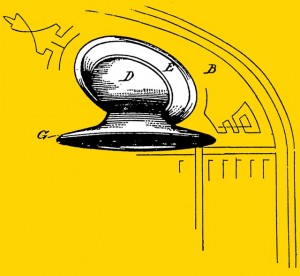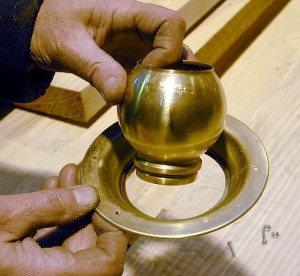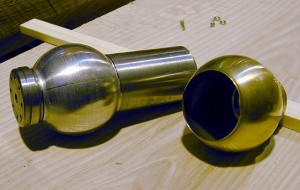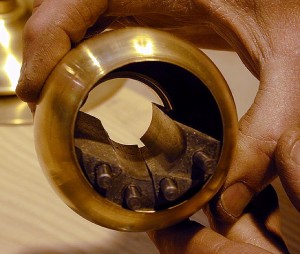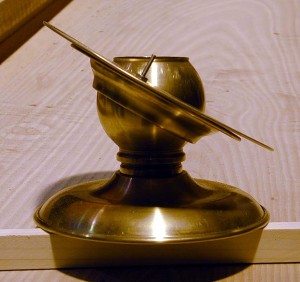Kirby’s Canopy – New Light on An Old Artifact
by Don Ginter, ©2002 MCRHS
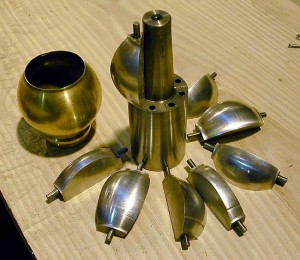
FIG. 4. Ball joint mandrel showing the “orange” sections that make up the ball joint’s spherical section.
When Delivered in 1888 from builder Barney & Smith, the interior lighting of the Milwaukee, Lake Shore & Western #63 and its six sister coaches consisted of eight single-burner kerosene side lamps. The side lamps were distributed four per side along the length of the coach, spaced out at approximately every four or five windows. They were mounted above the windows, exhausting their combustion byproducts into a venting system that piped it through the head lining panel. Not much light to read the latest issue of Railroad Gazette while traveling the 15-hour trip from Milwaukee to Ashland!
The venting hoods used on the MLS&W coaches were known as Kirby’s Canopy [Fig. 1]. It was invented around 1885 by John Kirby, Jr. Smoke-venting canopies were in use earlier in coaches, but this one had the advantage that it was adjustable—by a ball joint between its upper and lower sections—to the slope of the head lining panel. Earlier vents were rigid systems specifically built to fit the slope of the head lining panel and fix the lower canopy at a right angle to the lamp chimney. The Kirby’s Canopy enabled the smoke vent to be mounted on any head lining pitch and the lower canopy then could be adjusted normal to the lamp chimney. This canopy, with its advantage over rigid, specifically-built canopies, now could be made in quantities and stocked for future car orders, an important advantage for the manufacturer and car builder.
In 1885, when John Kirby, Jr. invented his adjustable canopy, he was Treasurer and General Manager of the Dayton Manufacturing Co. in Dayton, Ohio. Earlier, Barney & Smith had been producing some of their own coach ornamentation hardware and also buying from outside manufacturers. The Barney & Smith management decided to expand their coach ornamentation hardware business in 1883, therefore spinning off this portion of the business and incorporating it as the Dayton Manufacturing Co. John Kirby, Jr., then working as manager of Post & Company, a competing car trimming manufacturer in Cincinnati, Ohio, was invited to head up the new venture for Barney & Smith.
By 1970, when the museum acquired our MLS&W coach, all the Kirby’s Canopies had disappeared. The Chicago & North Western Railway upgraded the lighting by adding five center-hung double-burner kerosene lamps and replacing all the side lamps by 1913 or earlier. The canopies’ hole through the head lining panel was covered with a sheet of tin the same size as the panel, the exterior hole in the tin roof was patched over and soldered up with a new piece of terne metal (a steel plate coated with lead and a small amount of tin made specifically for roofing metal which assists in soldering the pieces together). While we lost all the canopies in the lamp modification update, we did gain some stenciled head lining panels that had remained undisturbed under the tin sheets since 1913. Since the focus of this project was to authentically restore the coach to the MLS&W ownership era (1888-1893) it would be necessary to replicate the Kirby’s Canopies using the identical manufacturing method as the originals—metal spinning. One of our members had a canopy in his collection and allowed us to use it as a pattern.
Metal spinning is a manufacturing process that can be used to form round, symmetrical shapes from thin sheet metal, steel, tin, copper, or brass. In metal spinning, a piece of sheet metal—in our case brass—cut to the required diameter is mounted to the front of a mandrel that duplicates the inside contour of the required finished part. This mandrel, with the sheet stock attached to the front, is mounted in a lathe. While spinning, the sheet stock is continuously formed around the pattern mandrel by using a small roller or hand tool to force the sheet metal against the pattern mandrel. This manufacturing method provided a simple straight-forward answer to making a majority of the shapes necessary to replicate the Kirby’s Canopy. The one exception was the ball joint which allows for adjustment between the top and bottom sections of the canopy.
Fig. 2 shows the finished shape of the ball joint and its lower collar. If using a solid mandrel that has the internal profile of the ball joint, it would be impossible to withdraw the mandrel from the completed spun ball joint [Fig 3]. Removing the mandrel is accomplished by making the spherical ball portion of the pattern sectioned like an orange, with each section keyed to the central mandrel [Fig 4]. To remove the mandrel from the completed spun ball joint, a keyed collar is removed from the end of the central mandrel, the central mandrel is then pulled out the opposite end of the newly-spun ball joint leaving the sections of the spherical pattern still in the ball joint. These sections are then individually removed from the interior of the ball joint, [Fig. 5].
Striving to create an authentic replica, our contractor brought the experience of a metal spinner, and knowledge of an exceptional machinist together to produce our Kirby’s Canopies which look and adjust identically to the original [Fig 6].

